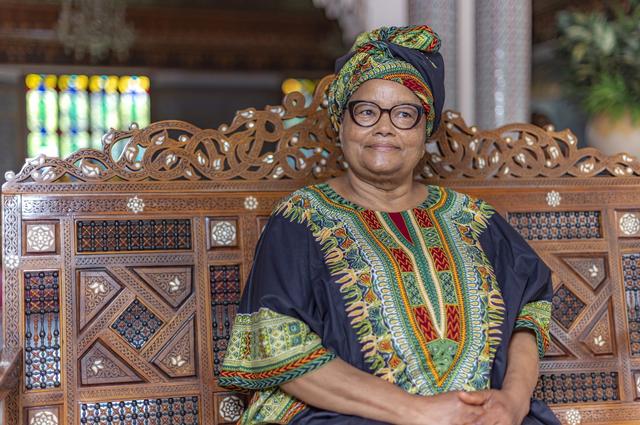Art, com', stars: what is the recipe for Richard Orlinski, this contemporary artist who fills the Olympia?
This Monday evening, the Olympia is full with a name that is surprising to say the least: the artist Richard Orlinski. On stage for a one-man show co-written with Laurent Baffie, he adds another string to his bow. But what is the secret formula of this artist that you will not see in any museum?
This Monday evening, his name will be in red letters on the facade of the Olympia Bruno Coquatrix: Richard Orlinski is completing the tour of his one-man show, "Tête de Kong", co-written with Laurent Baffie who is at the initiative of this show. But before his first steps as a comedian on stage, Richard Orlinski made a name for himself as a sculptor, renowned for his "pixelated" animals, and as a DJ.
Richard Orlinski's recipe is a mystery: he is today one of France's best-known and best-selling contemporary artists, while remaining cautiously aloof from the "conventional" art world. You won't find it in major modern art museums or renowned art fairs and galleries.
But why does Richard Orlinski have this atypical place in the art world? Is it kept away from the usual circuits because it irritates... or because it does not convince the specialists? And above all, is Orlinski really ostracized from this environment, or does he keep himself as far away as possible, not hesitating to speak out to denounce an "inter-self"? We have tried to analyze the magic recipe of this successful artist.
10% David Lynch: a jack-of-all-trades
Like the famous director of Dune and Blue Velvet, but also a musician, visual artist and nightclub owner, Richard Orlinski multiplies the disciplines. Convinced that we "will see a lot of connections between art and music", he launched in 2016 with a very dance title entitled "Heartbeat". Smart, in the clip, we discover... a 3D version of "Kong", the sculpture representing a gorilla emblematic of the sculptor.
After the music, here is the stage: based on an idea by comedian and playwright Laurent Baffie, Richard Orlinski will tell his career as a sculptor from a humorous angle. After several running-in dates in France and the Olympia on Monday, it will be in a smaller Parisian venue from September.
And to close the loop, Richard Orlinski wrote a song to go along with the show: Tête de Kong. There too he stages, in the clip, his gorilla, animated. It is this sculpture that accompanies him on stage.
30% Jeff Koons: an entrepreneur above all
Richard Orlinski's art is made of colorful pop statues, representing animals in particular but not only: he has also reinterpreted them, in a very pop way and flashy, the Venus de Milo or the David of Michelangelo, but also icons of popular culture like Pikachu and Superman, or objects like a helmet or a shoe with heels. An artistic treatment that is reminiscent of the work of a certain Jeff Koons, one of the most expensive living artists in the world. And that may not be a coincidence.

Because like Koons, Richard Orlinski is above all a team leader - not to say a business leader. If he draws his characters and his sculptures himself, the latter are executed in his workshop, where a hundred people work. Thus, on the artist's website, we discover that Orlinski's sculptures are not necessarily unique pieces, and that some exist in several materials or colors - this is also the case with Jeff Koons, whose famous Balloon Dog exists in several colors.
As for the concept that guides his artistic practice, called "Born Wild" and which defends the idea that we can release the wild energy of living beings into a positive emotion, it is... a registered trademark. By consulting the registration of the mark at the Inpi, the national property institute, we discover that Orlinski has registered it in the categories including "metal art object" or "porcelain art object", but also "clothing", "games and toys", "drinks", "alcoholic beverages".
And that's not all: like the American artist, he does not hesitate to sign collaborations with brands, companies, and sometimes communities. If we look at its exhibitions, most take place in large hotels, or in partnership with major brands. For example, after following the Longines watch factory, he now designs models for another house, Hublot.
Thus, Orlinski does not need to be in the traditional circuit to sell - he even offers himself the luxury of opening his own art gallery, rue du Faubourg Saint-Honoré in Paris. This is what allows him to detach himself from the art world to better criticize it: on the website of his gallery, we can read:
30% Andy Warhol: the friend of the stars and communication
You will easily read Richard Orlinski is "the best-selling French artist in the world" (which is false) or sometimes "the second best-selling French artist in the world" (which is true). According to the rankings compiled by the Artprice site, cited as a reference on Richard Orlinski's site, the artist comes behind the painters Pierre Soulages or Robert Combas. But one detail is missing: there are hardly any French artists in these rankings.
Thus, in the Top 500 contemporary artists in the world published last year, Orlinski is actually 95th (with $2.2 million in sales between July 2017 and June 2018). If we add non-contemporary artists, he is in 340th place. In other words, Orlinski's works sell well but cannot compete with a Picasso, a Basquiat or a David Hockney.
Richard Orlinski's coup de force lies in his communication. Like Andy Warhol, he made his own name a "brand", which alone is enough to sell. And like Warhol, it is also by appearing alongside other stars that Richard Orlinski makes a name for himself in show biz. His sculptures are on TV sets (as below in Arthur's show on TF1, but also in "The Voice" or "Les Anges de la Télé-Réalité"), at the top of the slopes of the very popular station of Courchevel or become trophies for the W9 channel. Like the Pope of Pop Art fifty years ago, Orlinski understood that an artist's notoriety almost inevitably passes through the mass media.
On his site, the artist has created a "People" section, where he appears alongside many celebrities, and where we see Sting proudly displaying one of his statues. And to promote his show, he brings in two of his friends, actor Christophe Lambert and TV presenter Bernard Montiel.
15% Xavier Veilhan: an undeniable resemblance... but no plagiarism
When you see the work of Richard Orlinski, it's hard not to think of another contemporary French artist: Xavier Veilhan . The two artists have in common their very "pixelated" way of representing humans and animals. The resemblance between the bears of the two artists is striking. That between the lion of Orlinksi and that of Veilhan posed in Bordeaux is even more obvious.
In 2014, Xavier Veilhan, who began his work in the early 2000s, sued Richard Orlinski, not for plagiarism but for "parasitism", believing that there was a risk of confusion between their work respective. The High Court of Paris dismissed Xavier Veilhan, considering that the subject of the work, that is to say the purpose behind the work, was not the same.
But above all - and this is the most interesting - the judge included in his decision the fact that Veilhan and Orlinski, although both sculptors, do not belong to the same world. The Court indeed considered that there could not be any confusion, because the clientele of Xavier Veilhan is institutional, whereas that of Orlinski has above all a purpose of decoration. Paradoxically, it is therefore the closed side of the contemporary art milieu, which Richard Orlinski deplores, which saved him the day in this affair.
10% Salvador Dali: a bit of a megalomaniac?
Photo shoots, YouTube channel, Instagram account: in the end, Richard Orlinski's face is almost as well known as his works. The artist has even gone so far as to transform his name into a logo, turning the K of his name upside down to include the I. Like Salvador Dali, Orlinski makes his name alone a mark.
And in 2017, he published a book simply titled "Why I broke the codes" (ed. Albin Michel). A megalomaniac approach? Not if we are to believe the first lines of his book, in which he says he does not like talking about himself. If we are to believe the author himself, he would be extroverted but not egocentric... unlike Dali, therefore.
10% Marcel Duchamp (or Mr Brainwash): a lot of art with not much?
In the end, in which camp can we classify Richard Orlinski? Is he on the side of those who bring real novelty to the world of contemporary art... or of those who profit a little too much from a good (and simple) idea? It all depends on how one perceives one's position vis-à-vis the environment. If the withdrawal of Richard Orlinski is indeed a voluntary and assumed position, then we can compare it to the position of Marcel Duchamp, who in the 1910s had called into question all the certainties about art with great blows of pranks and of secret identities - his urinal, named "Fontaine" and signed R.Mutt, is the best known example.
But we can also think that if Richard Orlinski is left out of the classic circuit, it's because this circuit rejects him. In which case, he would only be a very commercial and rather clever artist surfing again and again on an infinitely exploitable vein, like the street artist Mr Brainwash, whom the famous and anonymous Banksy derides in his movie "Do the wall". What if Richard Orlinski was precisely between these two positions?








